Mechanical Properties and Energy-Absorption Capability of a 3D-Printed TPMS Sandwich Lattice Model for Meta-Functional Composite Bridge Bearing Applications
Abstract
:1. Introduction
2. Methodology Strategy
2.1. Gibson–Ashby Model of Cell Structures
2.2. Schwarz Primitive (SP) Unit Cell Design
2.3. Finite Element Modelling of a Schwarz Primitive and Elastomeric Block Unit Cell
2.3.1. Design, Material, and Geometric Parameters
2.3.2. Mesh Generation
2.3.3. Boundary Conditions and an Applied Force
2.3.4. Material Properties
2.3.5. Data Collection
2.4. Mechanical Testing
3. Model Validation of the SP Unit Cell Model
4. Finite Element Modelling of a Proposed Novel SP Sandwich Lattice
5. Results and Discussion
6. Conclusions
- The mechanical response of a SP unit cell model under combined compression–shear loading is superior to that of an elastomeric block unit cell model, but it needs an increase in vertical stiffness under uniaxial compression by combining at least six SP unit cell models used as a SP sandwich lattice.
- During the testing, the three SP unit cell specimens fail in compression at a displacement of 9.3 mm and their failure behaviour is elastic–plastic due to the geometries, relative density, and material properties.
- The failure mode of the SP unit cell model under combined compression–shear loading is identified as a hysteretic behaviour at a displacement of 10 mm.
- The proposed novel SP sandwich lattice model exhibits the highest peak force and specific energy absorption under uniaxial compression at a displacement of 9.3 mm. However, under combined compression–shear loading, it still performs well with the highest peak shear force at a displacement of 10 mm.
- The stress–strain curve of this proposed lattice model under uniaxial compression loading condition is likely a typical bending-dominated one based on a Gibson–Ashby model.
- For bridge bearing applications, this proposed novel lattice model under compression-shear loading is likely to be stiff in the vertical direction and flexible in the horizontal one, in order to support the superstructure weight and accommodate horizontal displacements, respectively.
Author Contributions
Funding
Institutional Review Board Statement
Informed Consent Statement
Data Availability Statement
Acknowledgments
Conflicts of Interest
References
- Naeim, F.; Kelly, J. Design of Seismic Isolated Structures: From Theory to Practice; John Wiley & Sons: Hoboken, NJ, USA, 1999. [Google Scholar]
- Lee, D.J. Bridge Bearings and Expansion Joints; E & FN Spon: London, UK, 1994. [Google Scholar]
- Al-Anany, Y.; Tait, M. Fiber-reinforced elastomeric isolators for the seismic isolation of bridges. Compos. Struc. 2016, 160, 300–311. [Google Scholar] [CrossRef]
- Constantinou, M.; Kalpakidis, I.; Filiatrault, A.; Ecker, L.R. LRFD-Based Analysis and Design Procedures for Bridge Bearings and Seismic Isolators. Report No. MCEER-11e0004; Multidisciplinary Center for Earthquake Engineering Research: Buffalo, NY, USA; University at Buffalo: Buffalo, NY, USA; State University of New York: Buffalo, New York, NY, USA, 2011. [Google Scholar]
- Al-Anany, Y. Fiber Reinforced Elastomeric Isolators for Bridge Applications. Ph.D. Thesis, McMaster University, Hamilton, ON, Cananda, 2016. [Google Scholar]
- Sengsri, P.; Kaewunruen, S. Additive manufacturing meta-functional composites for engineered bridge bearings: A review. Constr. Build. Mater. 2020, 262, 120535. [Google Scholar] [CrossRef]
- AASHTO. LRFD Bridge Design Specifications; American Association of State Highway and Transportation Officials: Washington, DC, USA, 2012. [Google Scholar]
- Ramberger, G. Structural Bearings and Expansion Joints for Bridges; International Association for Bridges and Structural Engineering (IABSE): Zurich, Switzerland, 2002. [Google Scholar]
- Kelly, J.; Konstantinidis, D. Mechanics of Rubber Bearings for Seismic and Vibration Isolation; Wiley: Chichester, UK, 2011. [Google Scholar]
- Yasser, M.; Al-Anany, Y.; Michael, J.T. Experimental assessment of utilizing fiber reinforced elastomeric isolators as bearings for bridge applications. Compos. Part B Eng. 2017, 114, 373–385. [Google Scholar] [CrossRef]
- Al-Anany, Y.; Tait, M. A Study on the Rotational Behaviour of Bonded and Unbonded Fiber Reinforced Elastomeric Isolators. In Proceedings of the 11th Canadian Conference on Earthquake Engineering, Victoria, BC, Canada, 21–24 July 2015. [Google Scholar]
- Al-Anany, Y.; Tait, M. A numerical study on the compressive and rotational behavior of fiber reinforced elastomeric isolators (FREI). Compos. Struct. 2015, 133, 1249–1266. [Google Scholar] [CrossRef]
- Osgooei, P. Advanced Numerical Modeling of Fiber-Reinforced Elastomeric Isolators (FREIs). Ph.D. Thesis, McMaster University, Hamilton, ON, Canada, 2014. [Google Scholar]
- Toopchi-Nezhad, H.; Tait, M.; Drysdale, R. Bonded versus unbonded strip fiber reinforced elastomeric isolators: Finite element analysis. Compos Struct. 2011, 93, 850–859. [Google Scholar] [CrossRef]
- Sengsri, P.; Kaewunruen, S. Local Failure Modes and Critical Buckling Loads of a Meta-Functional Auxetic Sandwich Core for Composite Bridge Bearing Applications. Appl. Sci. 2021, 11, 10844. [Google Scholar] [CrossRef]
- Schoen, H. Infinite Periodic Minimal Surfaces without Selfintersections. NASA TN D-5541; National Aeronautics and Space Administration: Washington, DC, USA, 1970. [Google Scholar]
- Schwarz, H.A. Gesammelte Mathematische Abhandlungen; American Mathematical Soc.: New York, NY, USA, 1972. [Google Scholar]
- Sajadi, S.M.; Owuor, P.S.; Schara, S.; Woellner, C.F.; Rodrigues, V.; Vajtai, R.; Lou, J.; Galvão, D.S.; Tiwary, C.S.; Ajayan, P.M. Multiscale geometric design principles applied to 3D printed schwarzites. Adv. Mater. 2018, 30, 1704820. [Google Scholar] [CrossRef]
- Sun, G.Y.; Jiang, H.; Fang, J.G.; Li, G.Y.; Li, Q. Crashworthiness of vertex based hierarchical honeycombs in out-of-plane impact. Mater. Des. 2016, 110, 705–719. [Google Scholar] [CrossRef]
- Yang, Y.; Song, X.; Li, X.; Chen, Z.; Zhou, C.; Zhou, Q.; Chen, Y. Recent progress in biomimetic additive manufacturing technology: From materials to functional structures. Adv. Mater. 2018, 30, 1706539. [Google Scholar] [CrossRef]
- Yan, C.; Hao, L.; Hussein, A.; Raymont, D. Evaluations of cellular lattice structures manufactured using selective laser melting. Int. J. Mach. Tools Manuf. 2012, 62, 32–38. [Google Scholar] [CrossRef]
- Yan, C.; Hao, L.; Hussein, A.; Young, P. Ti-6Al-4V triply periodic minimal surface structures for bone implants fabricated via selective laser melting. J. Mech. Behav. Biomed. Mater. 2015, 51, 61–73. [Google Scholar] [CrossRef] [PubMed] [Green Version]
- Yan, C.; Hao, L.; Hussein, A.; Young, P.; Raymont, D. Advanced lightweight 316L stainless steel cellular lattice structures fabricated via selective laser melting. Mater. Des. 2014, 55, 533–541. [Google Scholar] [CrossRef] [Green Version]
- Mazur, M.; Leary, M.; Sun, S.; Vcelka, M.; Shidid, D.; Brandt, M. Deformation and failure behaviour of Ti-6Al-4V lattice structures manufactured by selective laser melting (SLM). Int. J. Adv. Manuf. Technol. 2016, 84, 1391–1411. [Google Scholar] [CrossRef]
- Al-Ketan, O.; Adel Assad, M.; Abu Al-Rub, R.K. Mechanical properties of periodic interpenetrating phase composites with novel architected microstructures. Compos. Struct. 2017, 176, 9–19. [Google Scholar] [CrossRef]
- Smith, M.; Guan, Z.; Cantwell, W.J. Finite element modelling of the compressive response of lattice structures manufactured using the selective laser melting technique. Int. J. Mech. Sci. 2013, 67, 28–41. [Google Scholar] [CrossRef]
- Zhang, L.; Feih, S.; Daynes, S.; Chang, S.; Wang, M.Y.; Wei, J.; Lu, W.F. Energy absorption characteristics of metallic triply periodic minimal surface sheet structures under compressive loading. Addit. Manuf. 2018, 23, 505–515. [Google Scholar] [CrossRef]
- Aremu, A.O.; Maskery, I.; Tuck, C.A. Comparative finite element study of cubic unit cells for selective laser melting. Self-supporting unit cells. In Proceedings of the 2014 International Solid Freeform Fabrication Symposium, Coventry, UK, 4–6 August 2014; pp. 1238–1249. [Google Scholar]
- Selo, R.R.J.; Catchpole-Smith, S.; Maskery, I.; Ashcroft, I.; Tuck, C. On the thermal conductivity of AlSi10Mg and lattice structures made by laser powder bed fusion. Addit. Manuf. 2020, 34, 101214. [Google Scholar] [CrossRef]
- Simsek, U.; Arslan, T.; Kavas, B.; Gayir, C.E.; Sendur, P. Parametric studies on vibration characteristics of triply periodic minimum surface sandwich lattice structures. Int. J. Adv. Manuf. Technol. 2020, 115, 675–690. [Google Scholar] [CrossRef]
- Habib, F.N.; Iovenitti, P.; Masood, S.H.; Nikazad, M. Cell geometry effect on in-plane energy absorption of periodic honeycomb structures. Int. J. Adv. Manuf. Tecnol. 2018, 94, 2369–2380. [Google Scholar] [CrossRef]
- Sarvestani, H.Y.; Akbarzadeh, A.H.; Niknam, H.; Hermenean, K. 3D printed architected polymeric sandwich panels: Energy absorption and structural performance. Compos. Struct. 2018, 200, 886–909. [Google Scholar] [CrossRef]
- Sugiyama, K.; Matsuzaki, R.; Ueda, M.; Todoroki, A.; Hirano, Y. 3D printing of composite sandwich structures using continuous carbon fiber and fiber tension. Compos. Part A-Appl. S. 2018, 113, 114–121. [Google Scholar] [CrossRef]
- Ling, C.; Cernicchi, A.; Gilchrist, M.D.; Cardiff, P. Mechanical behaviour of additively-manufactured polymeric octet-truss lattice structures under quasi-static and dynamic compressive loading. Mater. Des. 2019, 162, 106–118. [Google Scholar] [CrossRef]
- Abueidda, D.W.; Elhebeary, M.; Shiang, C.S.; Pang, S.Y.; Abu, A.; Jasiuk, I.M. Mechanical properties of 3D printed polymeric gyroid cellular structures: Experimental and finite element study. Mater. Des. 2019, 165, 107597. [Google Scholar] [CrossRef]
- Askarinejad, S.; Choshali, H.A.; Flavin, C.; Rahbar, N. Effects of tablet waviness on the mechanical response of architected multilayered materials: Modeling and experiment. Compos. Struct. 2018, 195, 118–125. [Google Scholar] [CrossRef]
- Sang, L.; Han, S.; Peng, X.; Jian, X.; Wang, J. Development of 3D-printed basalt fiber reinforced thermoplastic honeycombs with enhanced compressive mechanical properties. Compos. Part A Appl. Sci. Manuf. 2019, 125, 105518. [Google Scholar] [CrossRef]
- Ashby, M.F.; Medalist, R.M. The mechanical properties of cellular solids. Metall. Trans. 1983, 14, 1755–1769. [Google Scholar] [CrossRef]
- Triply Periodic Level Surfaces, Archived. 2019. Available online: http://www.msri.org/publications/sgp/jim/geom/level/library/triper/index.html (accessed on 28 August 2021).
- Abaqus CAE User’s Guide; DS Simulia Abaqus: Providence, RI, USA, 2017.
- Standard Drawings for Highway Design and Construction 2015 Revision, Thai Version. 2015. BP-102. Available online: http://www.doh.go.th/uploads/tinymce/service/bid/doc_bid/STANDARD%20DRAWING%202015%20EDITION_2018.pdf (accessed on 18 December 2021).






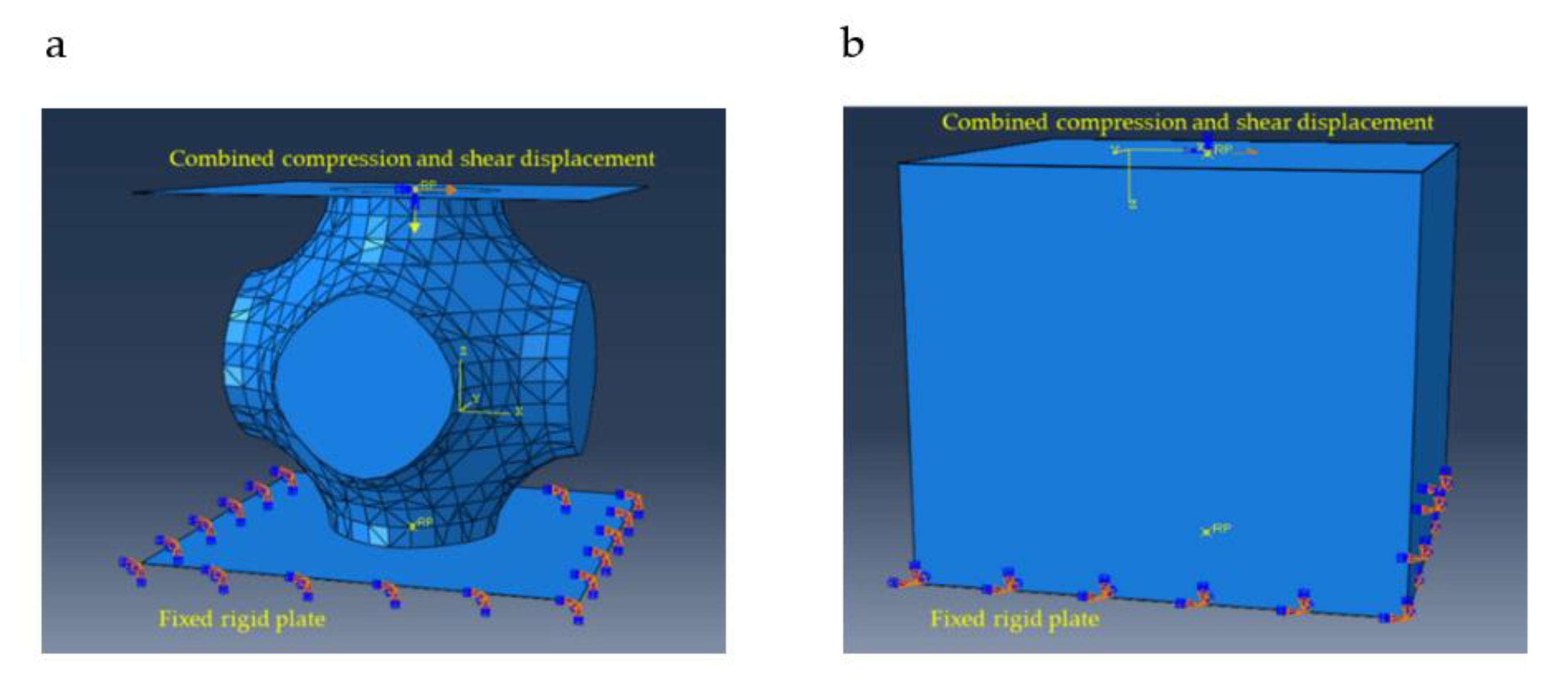
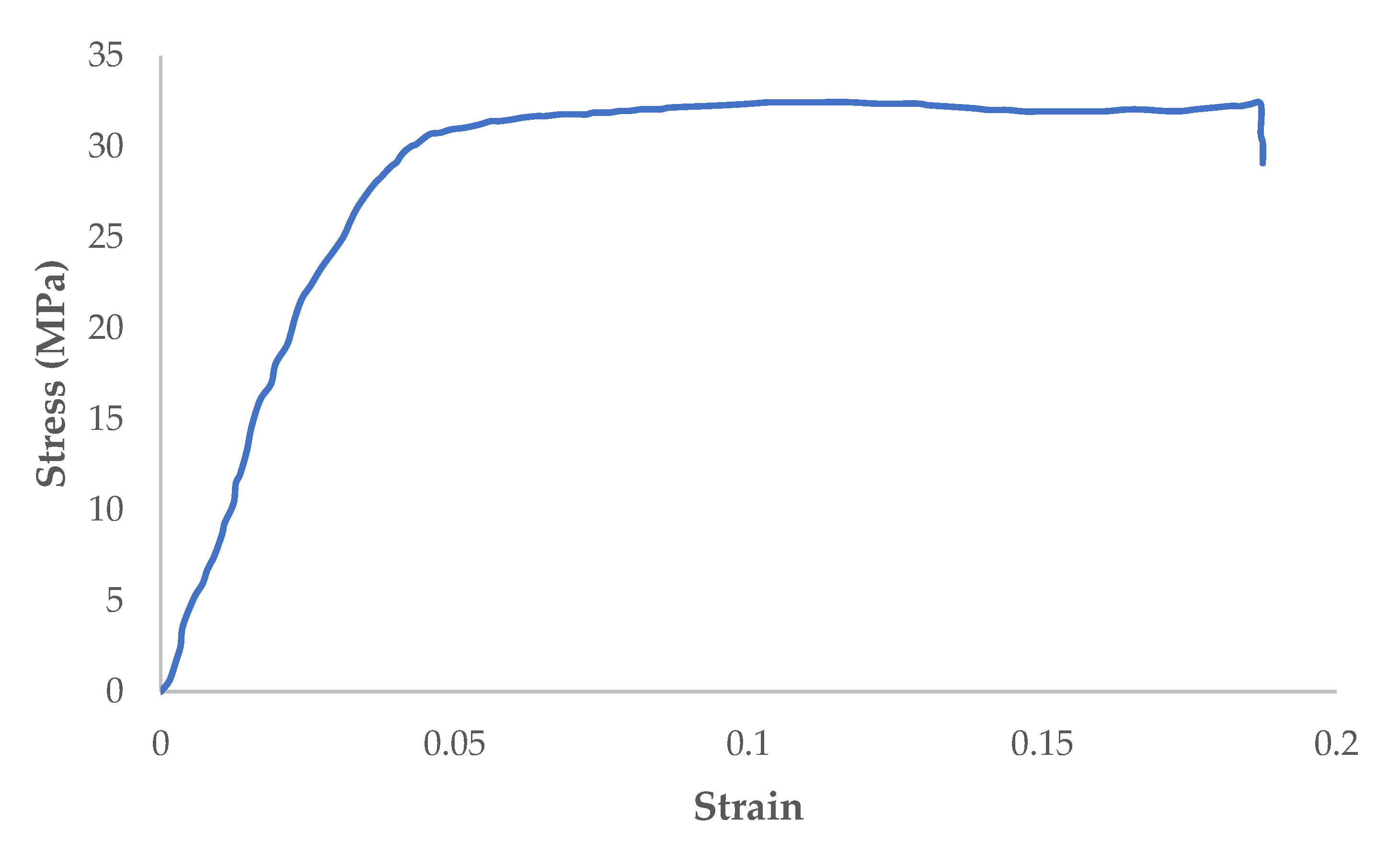



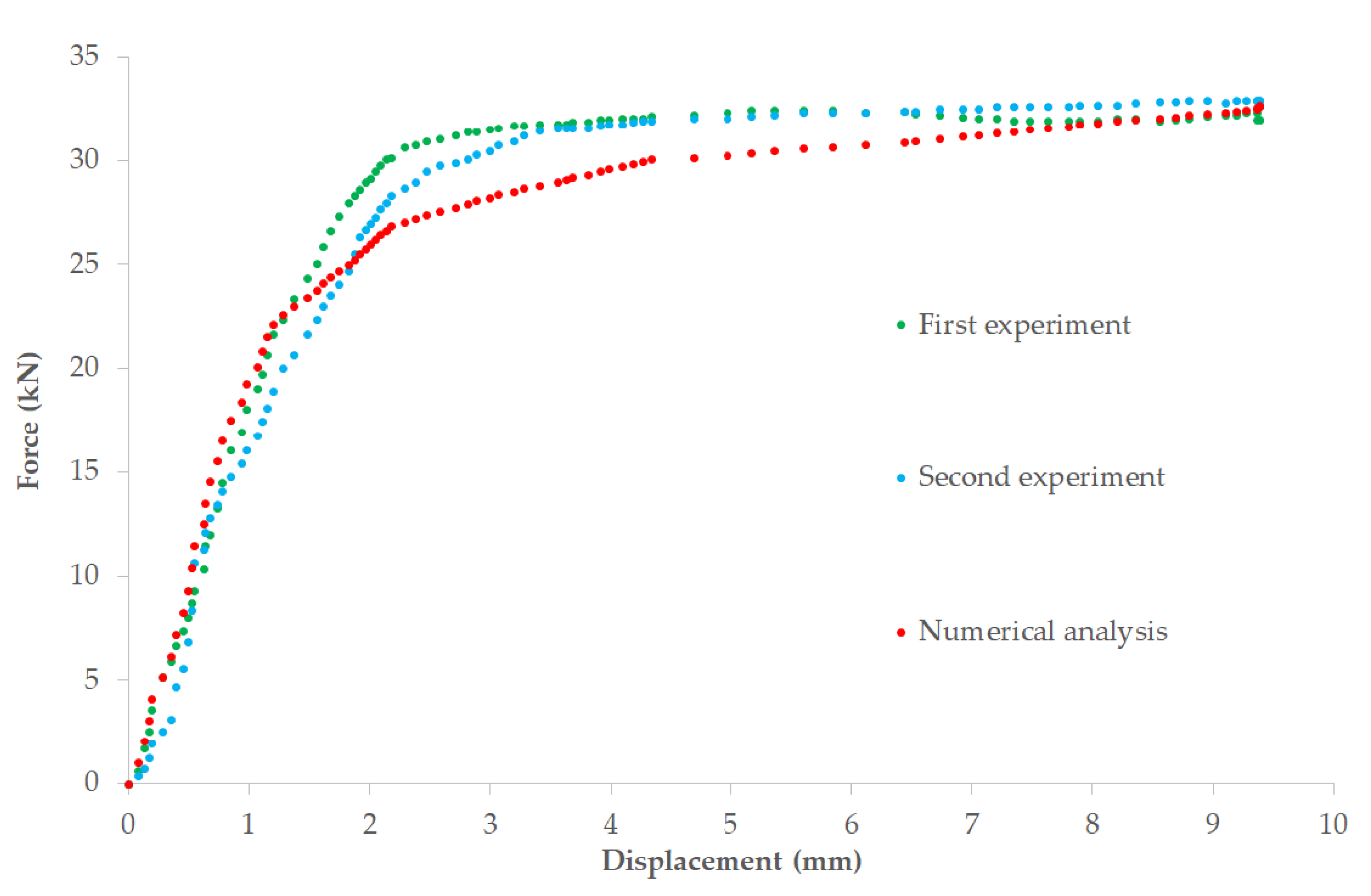


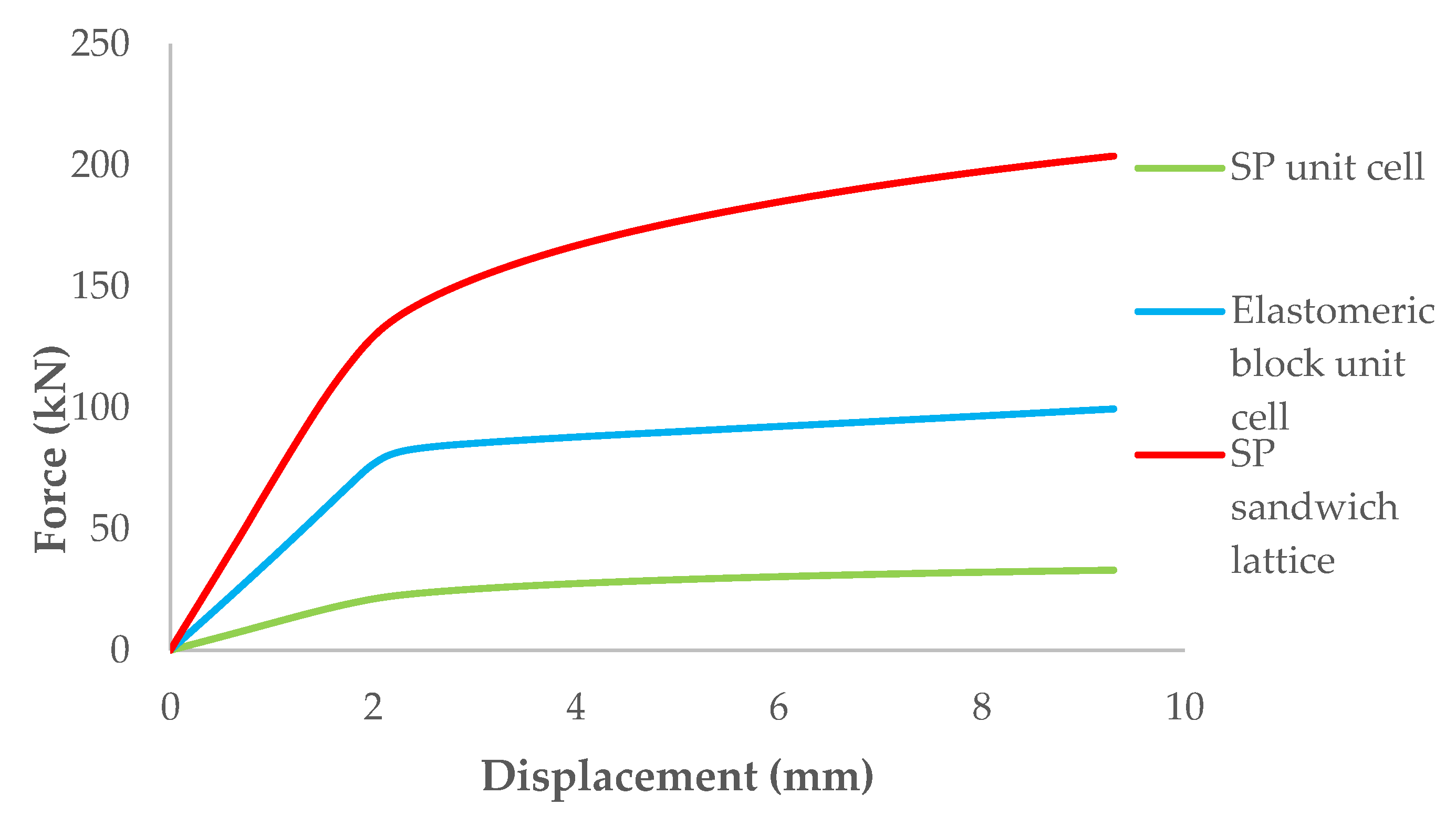
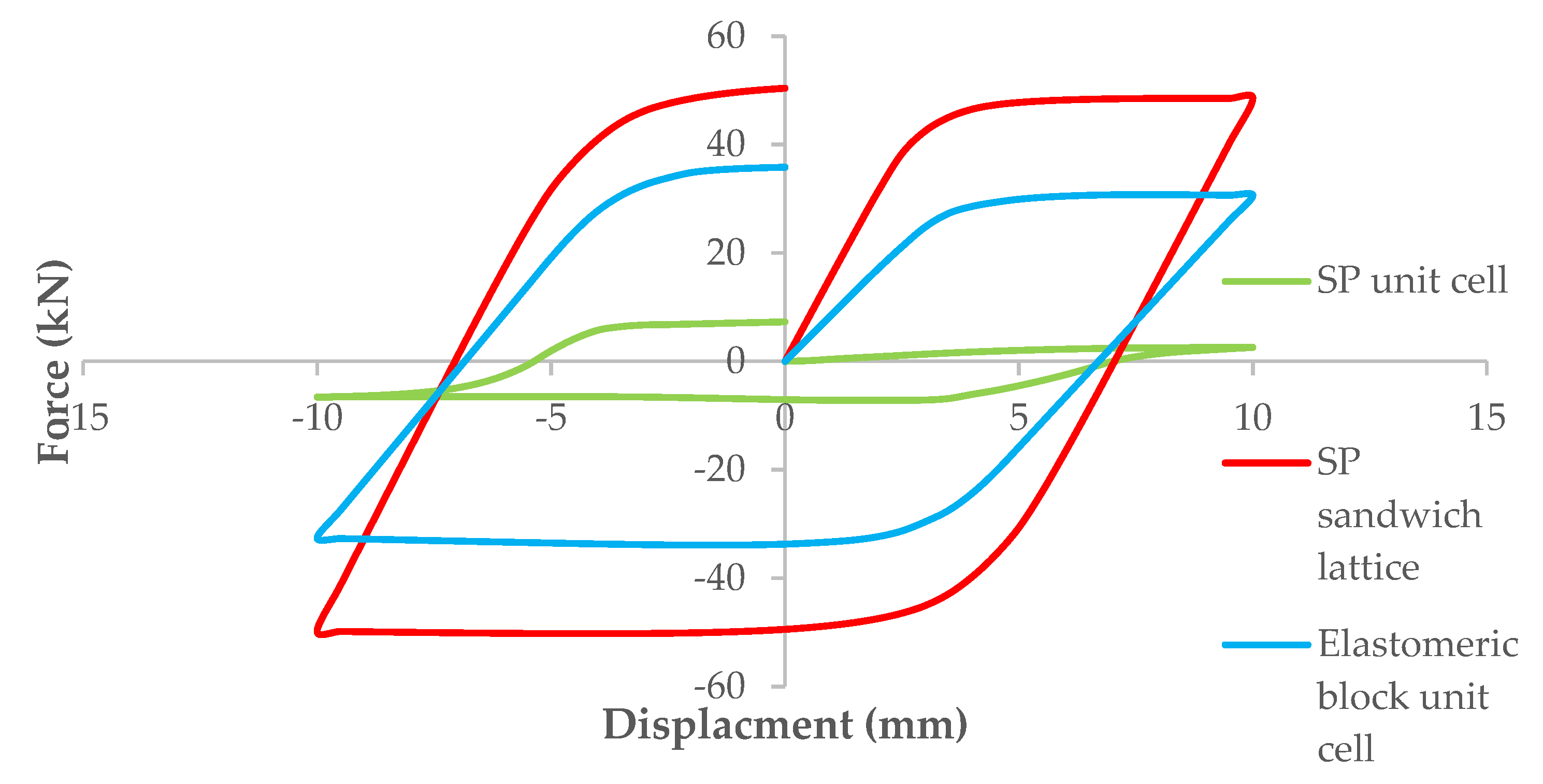
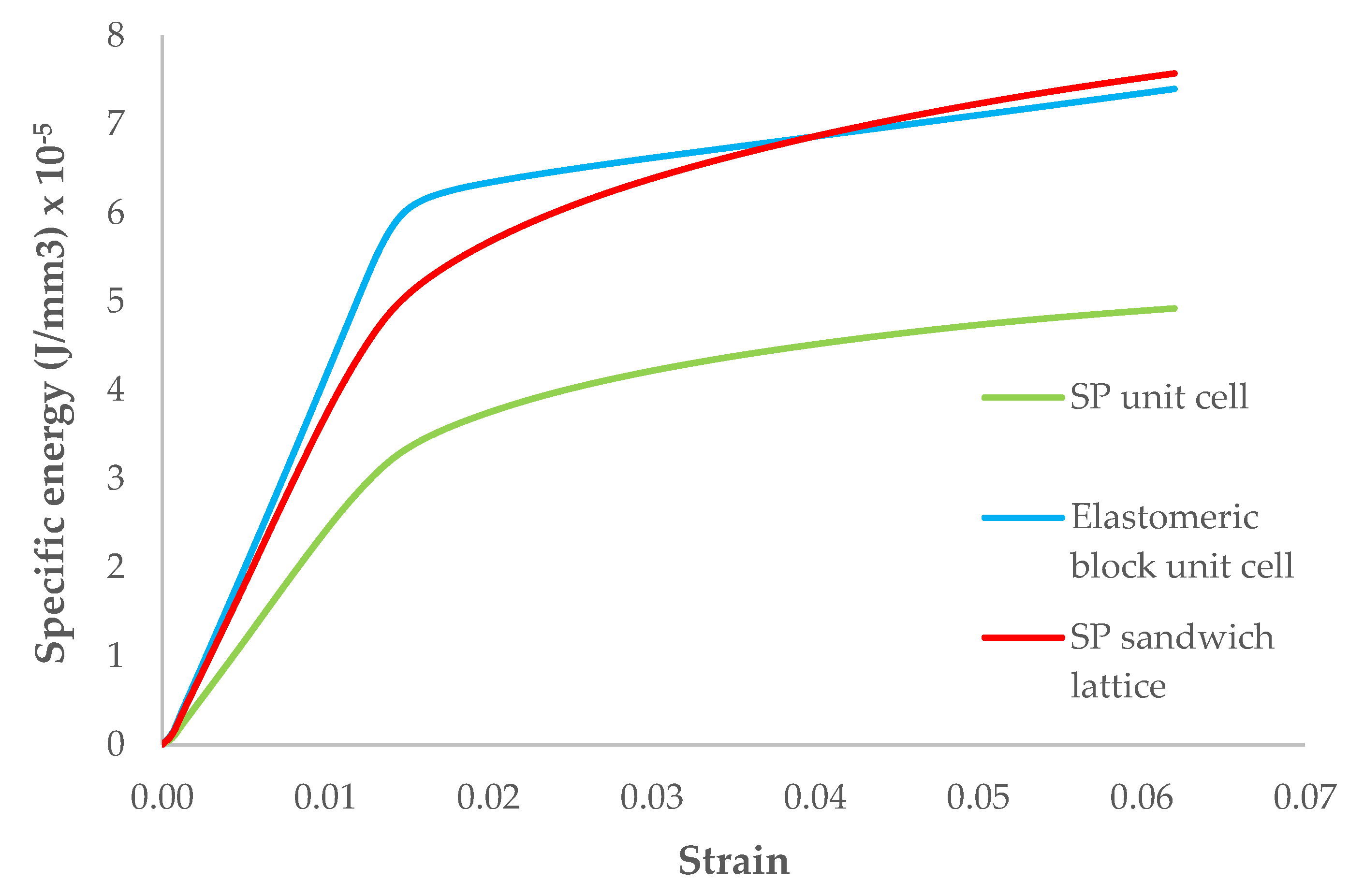


| Proposed Material | Young’s Modulus, Esp (MPa) | Shear Modulus, Gsp (MPa) | Poisson’s Ratio, Vsp | Total Absorption Energy (J) |
|---|---|---|---|---|
| UV resin | 213.56 | 153.33 | 0.36 | 2153.97 |
Publisher’s Note: MDPI stays neutral with regard to jurisdictional claims in published maps and institutional affiliations. |
© 2022 by the authors. Licensee MDPI, Basel, Switzerland. This article is an open access article distributed under the terms and conditions of the Creative Commons Attribution (CC BY) license (https://creativecommons.org/licenses/by/4.0/).
Share and Cite
Sengsri, P.; Fu, H.; Kaewunruen, S. Mechanical Properties and Energy-Absorption Capability of a 3D-Printed TPMS Sandwich Lattice Model for Meta-Functional Composite Bridge Bearing Applications. J. Compos. Sci. 2022, 6, 71. https://doi.org/10.3390/jcs6030071
Sengsri P, Fu H, Kaewunruen S. Mechanical Properties and Energy-Absorption Capability of a 3D-Printed TPMS Sandwich Lattice Model for Meta-Functional Composite Bridge Bearing Applications. Journal of Composites Science. 2022; 6(3):71. https://doi.org/10.3390/jcs6030071
Chicago/Turabian StyleSengsri, Pasakorn, Hao Fu, and Sakdirat Kaewunruen. 2022. "Mechanical Properties and Energy-Absorption Capability of a 3D-Printed TPMS Sandwich Lattice Model for Meta-Functional Composite Bridge Bearing Applications" Journal of Composites Science 6, no. 3: 71. https://doi.org/10.3390/jcs6030071
APA StyleSengsri, P., Fu, H., & Kaewunruen, S. (2022). Mechanical Properties and Energy-Absorption Capability of a 3D-Printed TPMS Sandwich Lattice Model for Meta-Functional Composite Bridge Bearing Applications. Journal of Composites Science, 6(3), 71. https://doi.org/10.3390/jcs6030071








